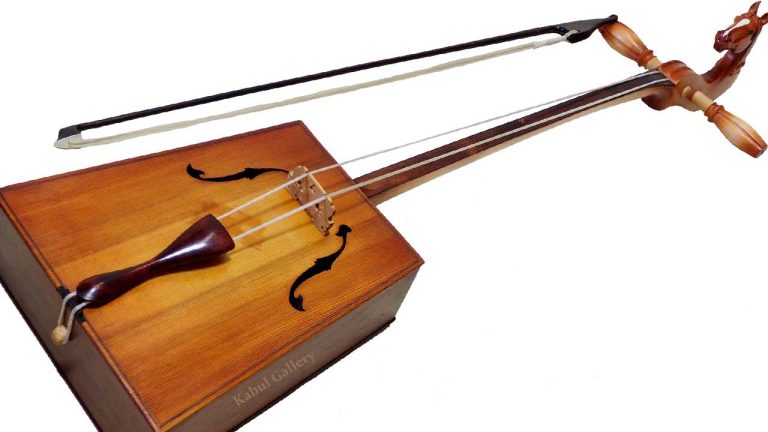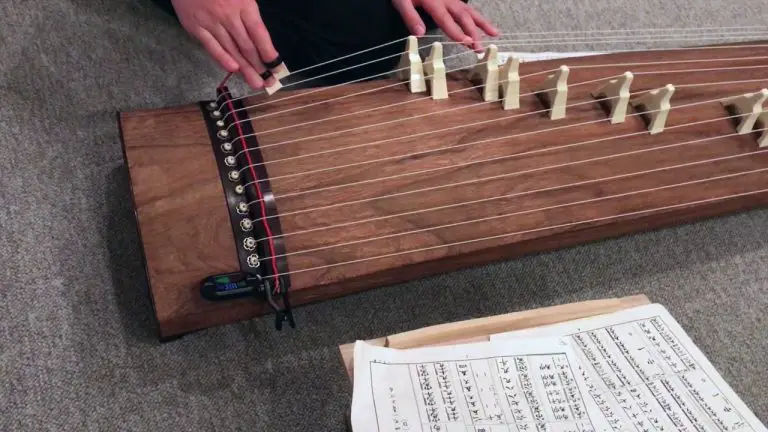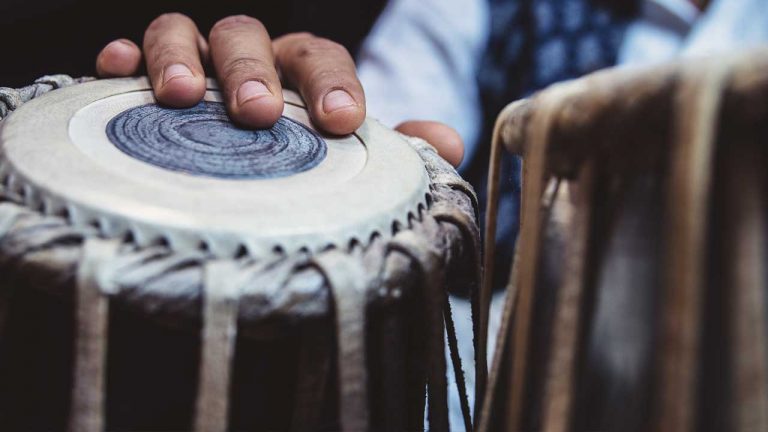Stringed Instruments in India: An Overview of Traditional Strings
Folkstrings.com is reader-supported. When you buy through links on our site, we may earn a small commission.
Stringed instruments have long been a cornerstone in the rich tapestry of Indian music, resonating through the ages with their distinctive sounds and styles.
My exploration begins with the traditional instruments like the veena and tanpura, whose origins are steeped in history and which continue to shape the sonic landscape of Indian classical music.
Each instrument carries its own story, its design intricately linked to the cultural and spiritual ethos of the region it emanates from.
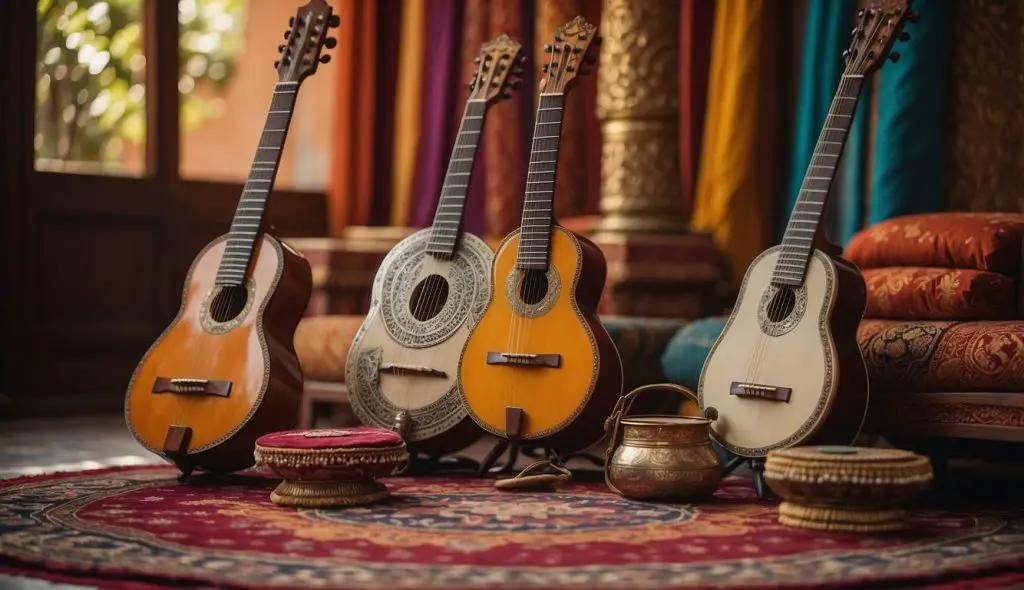
India’s repertoire of stringed instruments is vast, reflecting the diversity of the country itself. From the rhythmically complex sitar to the soulful sarangi, these instruments not only provide the melodic backbone to performances but also hold a mirror to the regional craftsmanship and musical philosophies inherent to Indian culture.
The evolution of these instruments has been gradual and reverent, paying homage to tradition while embracing innovation.
Key Points
- Stringed instruments play a pivotal role in the history and expression of Indian music.
- India boasts a diverse array of stringed instruments, each with regional and cultural significance.
- The craftsmanship behind Indian stringed instruments showcases a blend of traditional methods and innovative adaptations.
Table of Contents
History and Evolution of Stringed Instruments in India
In my exploration of India’s rich musical tapestry, I’ve found that the stringed instruments from this region hold a profound place in its cultural heritage, showcasing a fascinating journey from their ancient origins to contemporary innovations.
Ancient Roots and Vedic References
I’m particularly intrigued by the deep historical roots of Indian stringed instruments. The evidence of their existence goes back to the Vedic texts, among the oldest scriptures of Hinduism. The Rigveda mentions the veena, which I learned is one of the earliest known Indian string instruments. This instrument was initially used mainly for accompanying Vedic chants and rituals. Its design and structure have evolved over time, but it maintains its significance and revered status in Indian music.
Influence of Persian and Mughal Era
Moving forward in time, the Indian subcontinent witnessed significant cultural influences and exchanges during the Persian and the Mughal Empire’s rule, which greatly affected the development of musical instruments.
The introduction of the ravanahatha, considered an ancestor of the bowed instruments, is something I find particularly fascinating. Its name and design are thought to have origins in Sri Lanka (historically called Lanka), but it thrived in the northwestern regions of India.
Additionally, during the Mughal period, the sitar, another iconic Indian stringed instrument, began to incorporate Persian elements. It’s amazing to see how these cross-cultural exchanges enriched the craft of instrument-making and the techniques used by musicians.
Modern Adaptations and Innovations
In the contemporary scene, Indian stringed instruments have undergone substantial modifications. Builders and musicians continually update the instruments’ design for improved tonal quality and playability, which is a testament to the evolving nature of Indian craftsmanship.
I’ve seen modern sitars with advanced tuning mechanisms and the electrification of classical instruments like the veena, allowing for a broader range of sounds and integration with other music genres.
These adaptations have not only kept the instruments relevant but have also enabled them to reach new audiences globally.
Types of Stringed Instruments in Indian Music
Indian music is rich with a diverse array of stringed instruments, each uniquely contributing to the tapestry of sound I’ll explore here.
Plucked Instruments
Sitar: Commonly featured in Hindustani classical music, the sitar is identifiable by its long neck and pear-shaped gourd body. It usually has 18 to 21 strings, including sympathetic strings that resonate to produce a complex, reverberant sound.
Sarod: Similar to the sitar but with a more muted sound, the sarod is fretless and features a skin-covered resonator. This instrument typically has 17 to 25 strings, among which sympathetic strings add depth to its melancholic tones.
Veena: In Carnatic music, the veena holds a revered spot. It’s a large instrument with a resonating gourd and a long fretted neck. The veena is known for its deep, warm tones and is typically plucked with a plectrum.
Bowed Instruments
Sarangi: The sarangi is a highly expressive, bowed instrument with a short neck and three main strings. It’s often made from a single block of wood. The playing style closely mimics human vocal techniques.
Violin: Although not indigenous to India, the violin has been adapted into Indian classical music with significant stylistic changes in bowing and tuning. It’s used extensively across both Northern and Southern Indian music traditions.
Fretted and Non-Fretted Instruments
Fretted: I find that fretted instruments, like the sitar, have raised frets that allow for precise control of pitches. The use of these frets facilitates the distinctive slides and microtonal variations essential in Indian music.
Non-Fretted: In contrast, non-fretted instruments, such as the sarod, grant more freedom in gliding between notes, a technique vital for the fluid ornamentation characteristic of Indian musical expression.
Cultural Significance and Regional Variations
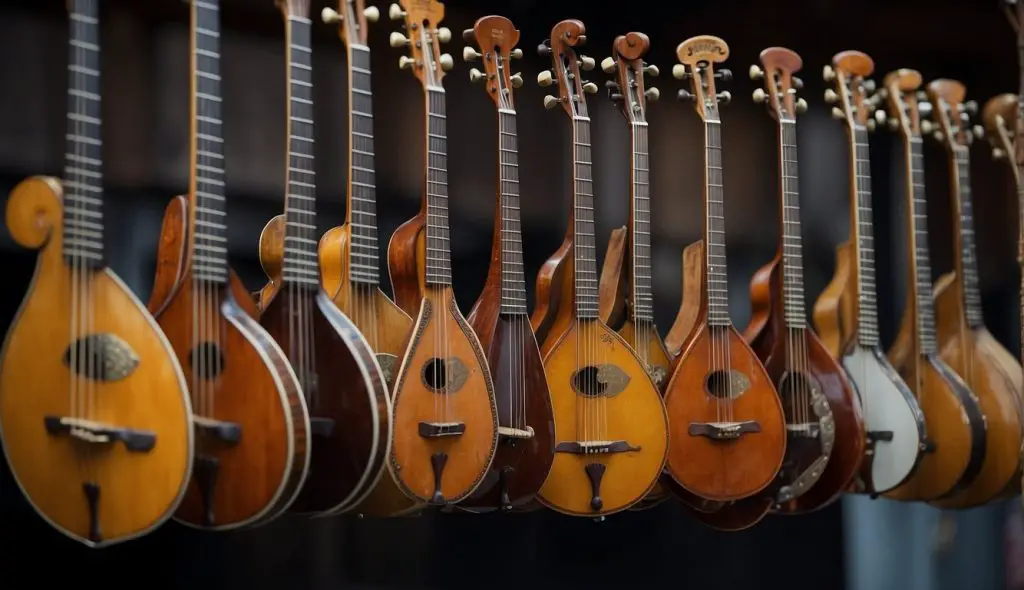
In my exploration of Indian stringed instruments, I’ve observed that their cultural significance is deeply rooted, and regional variations add a rich tapestry to the musical landscape of the country.
Northern and Southern Traditions
In North India, the Hindustani classical music tradition employs stringed instruments like the sitar and sarod. These instruments are fundamental to the musical ethos of regions such as Kashmir and Punjab. The use of rabab in Kashmir and tumbi in Punjab underscores the regional adaptations that characterize Hindustani music.
Conversely, South India is renowned for its Carnatic music tradition where the veena reigns supreme, encapsulating the essence of southern musicality.
Role in Classical and Folk Music
Stringed instruments are pivotal in both classical and folk music of India. Classical music—both Hindustani and Carnatic—reveres these instruments for their intricate melodic contributions. Specifically, Carnatic music showcases elaborate improvisations on the veena.
In the realm of folk music, the versatility of stringed instruments is evident. For instance, Rajasthan’s folk scene frequently features the ravanahatha and sarangi, emphasizing the unique sound of regional folk tunes.
Stringed Instruments in Dance and Theater
The integral role of stringed instruments extends into the performing arts such as dance and theater. Ancient texts like the Natya Shastra highlight the importance of musical instruments in stage performances.
Stringed instruments not only accompany dancers but also drive the narrative forward in dramatic pieces. They create the auditory atmosphere that’s essential for natya or dramatics. This is especially prevalent in classical dance forms where music and movement are inseparable.
Famous Musicians and Their Contribution
In this section, we’ll explore the impact of prominent figures who’ve played stringed instruments in India and how they’ve extended their influence globally.
Maestros of the Stringed Instruments
Indian classical music is graced by several maestros who have mastered stringed instruments.
One iconic figure is Pandit Ravi Shankar, a virtuoso of the sitar. My admiration for his work is immense; he has elevated the status of Indian classical music on a global scale. His collaborations with Western musicians like George Harrison of The Beatles have introduced sitar music to audiences all over the world.
Another legend in this domain is Bismillah Khan, whose name is synonymous with the shehnai, a traditional Indian wind instrument often grouped with stringed instruments due to its emphasis on melody. Khan Sahab performed at the first Republic Day celebration of India and his performances are still regarded as some of the most profound expressions of Indian classical music.
Global Influence of Indian Stringed Instruments
The impact of Indian stringed instruments crossed oceans, influencing international music scenes.
The Beatles included the sitar in songs like “Norwegian Wood,” an idea spearheaded by George Harrison after his tutelage under Ravi Shankar. This incorporation spearheaded a trend of including Indian instruments in Western pop and rock music, influencing bands like The Rolling Stones and The Doors.
Through such cross-cultural exchanges, Indian stringed instruments became a symbol of the psychedelic era, and Ravi Shankar’s performances at concerts like the Monterey Pop Festival and Woodstock became emblematic of this profound global interaction.
My appreciation for these musicians and their craft goes deep, recognizing how they’ve woven the threads of Indian music into the tapestry of world culture.
Manufacturing and Craftsmanship
To truly appreciate Indian stringed instruments, it’s essential to understand the materials and methods that go into their construction. I’ll take you through the heart of what makes these instruments both durable and melodious.
Materials and Construction
When I think of stringed instruments from India, I’m reminded of the meticulous selection of materials. Tun wood is commonly preferred for its tonal quality and durability, making it a choice wood for the body of many instruments.
To create a hollow resonance chamber, craftspeople carefully carve and shape the wood. I’ve learnt that bamboo is often used for making the flutes and sometimes string instruments, renowned for its good quality and flexibility.
For the strings themselves, traditionally, gut was the primary material, but nowadays, metal strings are also quite popular due to their longevity and bright sound. Tuning pegs, often crafted from ebony or teak for their hardness and stability, ensure precise tuning stability.
Artistry and Techniques of Instrument Making
Indian instrument craftsmanship is an art that balances functionality with aesthetic beauty.
Artisans use a combination of hand tools and time-honored techniques to shape instruments, ensuring each piece resonates with the characteristic Indian sound.
The technique of stretching the strings across the hollow body is done with utmost precision to ensure proper tension. This tension is vital for creating the iconic resonating sound.
The mizraab, a plectrum used for playing the stringed instrument like the sitar, is skillfully fashioned from wire or plastic, designed for agility and comfort.
Throughout the process, I’ve observed a commitment to preserving the rich heritage behind the crafting methods while embracing new materials and advancements, showing a reverence for tradition alongside innovation.
Frequently Asked Questions
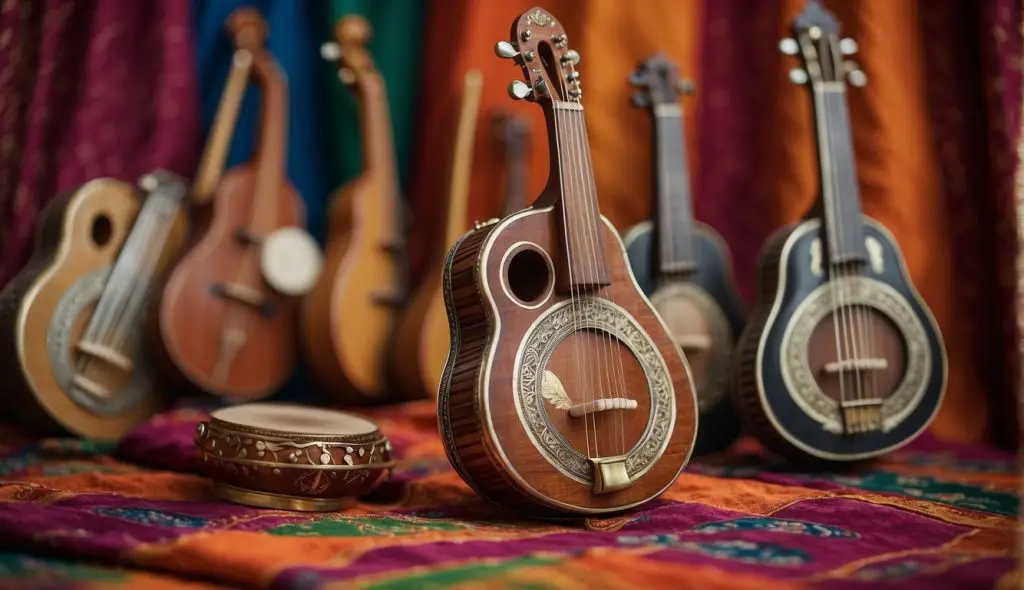
In this section, I’ll address some common curiosities surrounding Indian stringed instruments, their unique characteristics, and their significant role in classical music.
What are the different types of stringed instruments commonly used in Indian classical music?
Indian classical music heavily incorporates stringed instruments such as the sitar, sarod, tanpura, and veena.
These instruments are integral for melody and accompaniment.
Can you list some Indian stringed instruments that resemble the violin?
In India, the sarangi and esraj bear a close resemblance to the violin.
They are played with a bow and have a similar heartfelt sound quality that resonates deeply in classical Indian compositions.
What is considered to be one of the oldest stringed instruments in India with historical significance?
The veena is often recognized as one of the oldest stringed instruments in India.
It has roots dating back to the Vedic period and holds a prestigious place in Indian culture due to its mythological and historical significance.
Which stringed instrument in the Indian tradition is known for being beginner-friendly?
The tanpura is known for being beginner-friendly due to its role as a drone instrument in Indian classical music.
It’s relatively easier to learn the basics of playing the tanpura as it doesn’t require intricate finger techniques.
What Indian stringed instrument shares similarities with the guitar?
The Indian slide instrument called the Mohan veena is quite similar to the guitar. It is actually a modified Hawaiian guitar and has been used by Grammy-winning musician Vishwa Mohan Bhatt.
Could you provide some interesting facts about the role of stringed instruments in Indian music performances?
Stringed instruments are the soul of Indian music performances. The sitar, for example, became internationally famous through the work of maestros like Pandit Ravi Shankar.
These instruments are not just for melody; they also emphasize the complex rhythmic cycles and nuanced microtones that are unique to Indian music.
Author Profile
-
Daniel Johnstone is an English writer with a love for stringed instruments from around the world.
He shares his love for these instruments through his writing for folkstrings.com, a website dedicated to all things related to folk string music.
Daniel's passion for music started at a young age, and he has since become an accomplished musician, playing guitar, cavaco, and recently, the harp.
His dedication to learning and sharing his knowledge of stringed instruments is evident in his insightful and engaging blog posts. Whether you're a seasoned musician or a beginner, Daniel's writing is sure to inspire and entertain you.
When he's not playing music or writing, you can find Daniel exploring new instruments and seeking out new sounds to share with his readers.
Latest entries
 AutoharpApril 4, 2024What Is the Autoharp Made Of: Exploring Its Materials and Craftsmanship
AutoharpApril 4, 2024What Is the Autoharp Made Of: Exploring Its Materials and Craftsmanship AutoharpApril 4, 2024Is Autoharp Easy to Play? Unveiling the Truth for Beginners
AutoharpApril 4, 2024Is Autoharp Easy to Play? Unveiling the Truth for Beginners AutoharpApril 4, 2024What Is an Autoharp Worth? Your Guide to Pricing and Value
AutoharpApril 4, 2024What Is an Autoharp Worth? Your Guide to Pricing and Value AutoharpApril 4, 2024Are Autoharp and Zither the Same Thing? Unraveling String Instrument Myths
AutoharpApril 4, 2024Are Autoharp and Zither the Same Thing? Unraveling String Instrument Myths
Affiliates:
This post may contain affiliate links that at no additional cost to you, the site may earn a small commission. We only recommend products we would use ourselves and all opinions expressed on this site are our own.
Accuracy Advice:
While we strive to provide up-to-date and accurate information, the content in this article may not reflect the most current research or medical guidelines. We encourage readers to do further research and consult with professionals for more personalized advice.
Our Recommendations:
The products and services mentioned in any of our articles are recommended based on our independent research and personal experience. We are not sponsored by any company. We aim to suggest products and services we believe are of high quality and could be beneficial to our readers.


